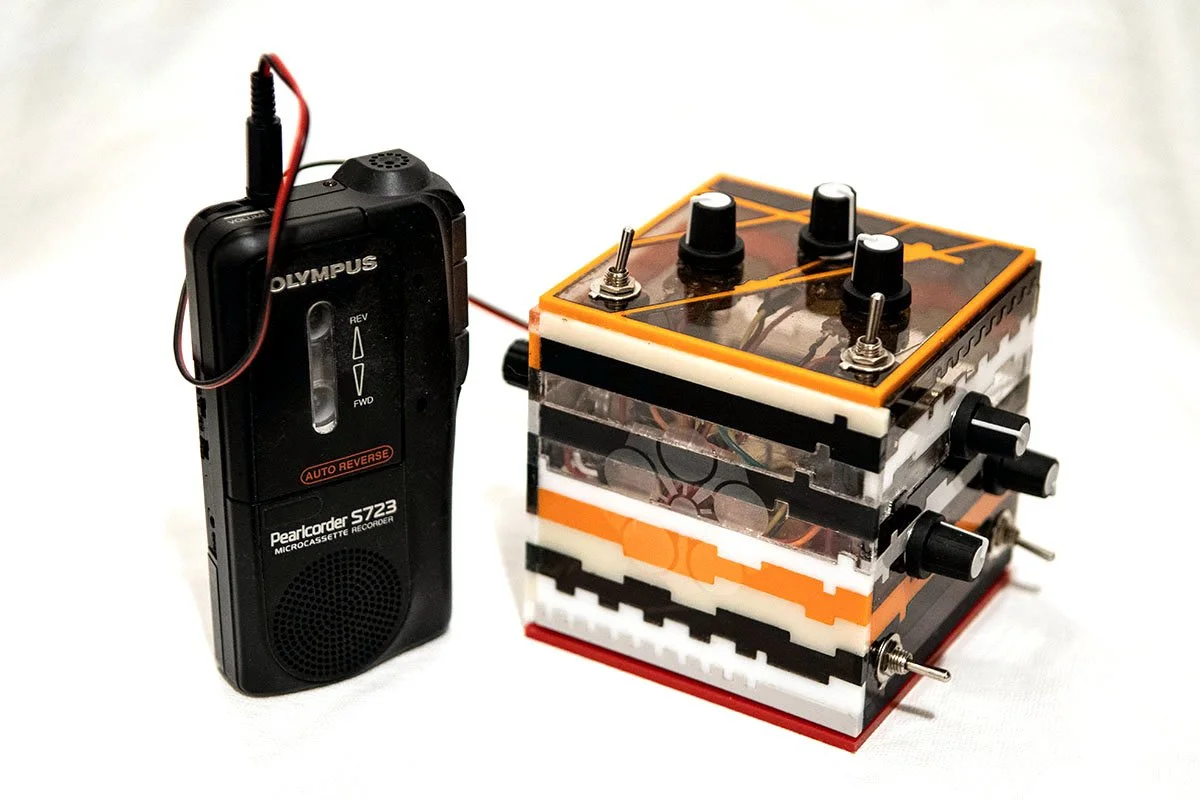Phasenpunkte
An analog art exhibit about the digital experience
06.09. – 15.09.2024
Gallery Reception: Friday, September 6, 6 – 10 PM
Sound art performance and artist opening September 7, 7 PM
Lucidbeaming, electronics and sound art
Samantha Tiussi, glass objects and sound art
Free admission
curated by Lucidbeaming at the invitation of Tobias Sternberg
Phasenpunkte ("phase points") is a reference to the points at which different materials change phase, like water turning to steam. It is used as a metaphor to relate to the transition points between organic human experience and virtual and synthetic spaces. The human phase points are our feelings, thoughts, and imagination. Our consciousness is the membrane between the virtual and the real. This show is an aesthetic response to that idea. It's not about technology, it's about being human.
Lucidbeaming
Lucidbeaming is an art and technology project by Berlin based artist Joshua Curry. It leverages a background in fine art and music with modern programming and fabrication skills. Artwork is created using multiple parallel projects, so ideas and processes cross-pollinate and yield interesting connections. A series of drawings connects with ways of manipulating images in a computer program. Computer generated text inadvertently informs a series of ink works on rice paper. When my projects succeed, people aren't focused on how something was made, but on the experience itself. The human and social aspect of all this is really the key.
Samantha Tiussi
Samantha Tiussi is a transdisciplinary artist based in Berlin, with a background in classical music and visual arts, currently works with performances and interactive installations. She has autism and ADHD, which gives her a different perception of the world. She explores her synesthesia creating sound spaces. The material glass, which she often uses in her research, comes from her childhood with her father, who worked with glass. Using elements such as sounds, technology, body, glass and artificial intelligence, the artist questions the concept of the "other" and creates imaginary ecosystems.
Hilde Maassen
"We live in uncertain times with enormous tensions in the economy, democratic politics and climate changes. I want to show what is already present in nature, but invisible to the human eye. By creating a bump map based on the contrast in the photo, I show a hidden spatial experience of the photo. It seems as if the photo, or part of it, breaks open and reveals what is inside. This way, a new truth is created. It is a surreal representation of the pain our world is already in. We are staring into a post-apocalyptic future from which we choose to look away."
Sofia Nercasseau
"Where I frame is where the attention is. Visual perception is a bridge between the external and the internal. There is no separation between environment, experience, imagination and memory. Hands as material exploration and observation as a perceptive phenomenon and an active method of conversation.
The experience of observing is transformative, it is to become what is seen. Everything I see is illuminated in some way. Light as a concept and energy that gives a limit to forms and that makes a photograph. I am interested in observing natural phenomena, especially in the plant kingdom as organisms that materialize with solar energy and empty or fold in the dark. As a matrix to develop images, links and relationships."
Gábor Ugray
Gábor Ugray is a Berlin-based generative artist with a background in computer science and linguistics. He uses code as a medium to express visual ideas, alternating between solitary exploration and performative live coding. He employs a pen plotter (a computer-controlled drawing machine) to capture programmatically generated forms on a physical medium. His work is rooted in a personal space of calm and focus where he retreats to create the visual algorithms underlying his art.
Cecilia Nercasseau Gibson
Cecilia Nercasseau Gibson, Cecilia Pez, is a multidisciplinary artist with a background in architecture and music. It moves between the material and the ethereal. Bodies and materials as vibrating elements in a vacuum, modelling themselves according to the frequencies that surround them. Materials sensitive to forces, to dialogues between elements in the same space. Architecture is to music
Like matter to vacuum
like Body to energy
As the physical to the frequency
As the Receiver and transmitter to the signal
As feelings to thoughts
As inspiration is to imagination.
Hajnal Szolga
Hajnal Szolga is a visual artist and photographer based in Berlin. She studied communication and media studies and philosophy in Hungary, and photography and media design in Germany. Her works offer critical views on social, ecological, and cultural issues. She studies human behavior affecting nature and its resources, focusing on the relationship between people and their environment, often reflecting on the consequences of climate change through her subjective, futuristic visions. She primarily works with analog technology, developing negatives and printing photographs in her darkroom.
Daniel Kannenberg
Daniel Kannenberg's surreal collages blend the mundane with the mystical. By combining designer furniture with ritualistic elements like masks and animal heads, he explores themes of culture, society, and the human condition. His dark, earth-toned rooms often feature absurdly masked figures and unsettling juxtapositions, challenging viewers to consider the interplay between nature and nurture, ritual and reality. Kannenberg's work delves into the universal patterns found in everything from everyday life to celestial bodies, ultimately inviting contemplation on the nature of existence and our place within it.








